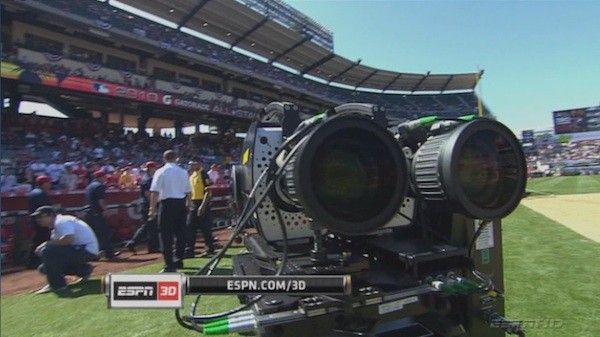How do you spell the end of 3DTV? Try ESPN. The cable sports giant is pulling the plug on its 3D channel due to what it calls limited demand. Where the channel was once hailed as a milestone in driving broad consumer adoption of 3DTV, its demise is now being called a foot in the grave for the format.
“Many in the industry have said over the last few years that if ESPN ever pulled the plug on 3-D TV, that would be the format’s final chapter,” wrote TV blogger Phillip Swann.
ESPN aired nearly 400 sports events in 3D since launching the network in 2010. It billed college football’s BCS championship games and major tennis events as among the most popular ESPN-3D broadcasts. Yet none of the programming drew big enough audiences to warrant rating by Nielsen. One research firm, SNL Kagan, estimated that the channel had under one million subscribers.

One 3D headache for ESPN – 3D cameras had to be close to the field
The 3DTV format met hurdles almost instantly at launch, among them people wary of purchasing yet another pricey TV set when many households had recently upgraded to HDTVs. They also required costly 3D glasses, with manufacturers only willing to include a pair with set purchases. That left families and anyone who enjoys watching TV with friends doing social graphing and wallet math at the point of purchase.
For sports fans, the death knell might have been more than limiting game day invites to how many pairs of glasses were available. The glasses worked better in captive programming such as movies. With sports, a room full of dark-goggled fans interacting around a game was just plain awkward. So awkward in fact that ESPN’s own 3DTV ads mocked it.
The reprieve for 3D adopters is that there’s no sign Hollywood is going to stop supporting 3D Blu-Ray. It certainly needs disc sales where it can get them. But ESPN’s decision is a major setback for televised 3D programming. At least one other 3D network, DirecTV’s n3D, has already reduced its programming from 24 hours a day due to limited content.
ESPN has said it will resume 3D programming if the demand is ever there. The network also said the experiment with 3D had its upsides, such as learning how to deal with having to place 3D cameras closer to the action than regular cameras at sports events.
Source: New York Times

